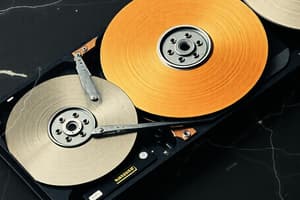Podcast
Questions and Answers
How close do the read/write heads fly above the disk platter?
How close do the read/write heads fly above the disk platter?
with clearance of as little as 3 nanometers
What is the role of the arm assembly in a hard disk?
What is the role of the arm assembly in a hard disk?
to read and write information from a set of platters
What happens when the arm assembly fails in a hard disk?
What happens when the arm assembly fails in a hard disk?
the drive fails
What is the purpose of the spindle in a hard disk?
What is the purpose of the spindle in a hard disk?
What is the movement of the arm that carries the read/write head called?
What is the movement of the arm that carries the read/write head called?
What is the primary component of a hard disk drive where magnetic data is stored?
What is the primary component of a hard disk drive where magnetic data is stored?
What is the smallest addressable portion of a disk?
What is the smallest addressable portion of a disk?
How is the storage capacity of a track calculated?
How is the storage capacity of a track calculated?
What is a group of contiguous sectors on a disk called?
What is a group of contiguous sectors on a disk called?
What is a set of tracks that are directly above or below each other on a disk called?
What is a set of tracks that are directly above or below each other on a disk called?
Flashcards are hidden until you start studying
Study Notes
Hard Disk Organization
- A hard disk drive (HDD) consists of five main components: platters, read/write heads, arm assembly, spindle, and arms.
- The platter is a circular disk that stores magnetic data on both sides (surfaces).
- Each platter is divided into concentric rings called tracks, which store information in successive tracks on the surface of the disk.
- Track capacity is calculated by multiplying the number of sectors per track by the bytes per sector.
Tracks and Sectors
- Each track is divided into a number of sectors, which are the smallest addressable portion of a disk.
- A sector typically holds 512 bytes of data.
- The operating system's file manager views the file as a series of clusters of sectors, where a cluster is a fixed number of contiguous sectors.
Cylinders
- A cylinder is a set of tracks that are directly above or below each other.
- All the information on a single cylinder can be accessed without moving the arm that holds the read/write heads.
- The number of cylinders is equal to the number of tracks on a surface.
- Cylinder capacity is calculated by multiplying the number of tracks per cylinder by the track capacity.
Read/Write Heads
- Read/write heads are small parts that move above the disk platter with a clearance of as little as 3 nanometers.
- Each surface has its own read/write head.
- The read-write head moves to the track that contains the data to be transferred.
Arm Assembly
- The arm assembly is an internal set of hard disk components that contain arms with read/write heads.
- The arm assembly reads and writes information from a set of platters coated with a thin magnetic material.
- If the arm assembly fails, the drive is considered failed.
Spindle
- The spindle holds the platters in a fixed position with enough space for the read/write arms to access the data.
- The spindle also rotates the platters, which moves the sector under the read-write head for reading or writing.
Arms
- The arms are used to carry, guide, and move the read/write head.
- Moving the arm is called seeking, and it is usually the slowest part of reading information from a disk.
Studying That Suits You
Use AI to generate personalized quizzes and flashcards to suit your learning preferences.




